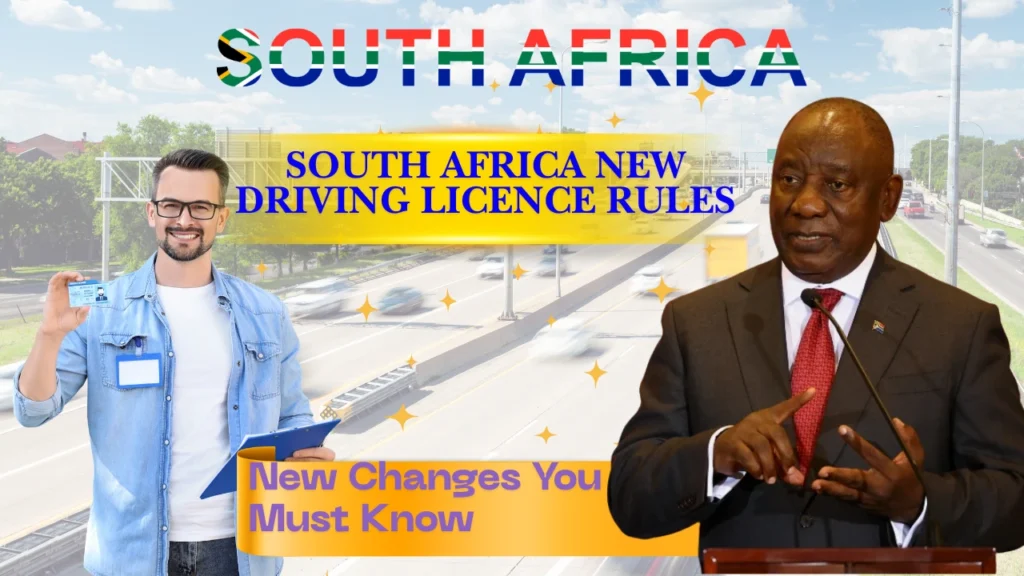South Africa New Driving Licence Rules 2025: Driving in South Africa just got a major overhaul. Beginning in 2025, the national government is introducing sweeping changes to how licences are issued, renewed, verified, and enforced.
These updates aim to modernize the system, reduce fraud, simplify processes, and enhance road safety. If you drive, plan to apply for a licence, or renew an existing one in South Africa, it’s critical to understand these new rules and how they might affect you. In this blog, we break down every key change, the expected benefits and challenges, and a practical guide for drivers navigating the new regime.
South Africa New Driving Licence Rules 2025-Overview
| Article on | South Africa New Driving Licence Rules 2025: New Changes You Must Know |
| Licence Type | Smart-card licence with embedded chip |
| Validity | 8 years |
| Application & Renewal | Online via government portal |
| Testing | Standardized, stricter theory & practical tests |
| Identity Verification | Mandatory biometric checks (fingerprint/face) |
Why the Change? The Driving Forces Behind the Reform
Before diving into the new rules themselves, it helps to know why the government felt a reform was necessary. Several pressing issues have pushed this overhaul:
- Rampant Fraud and Counterfeit Licences
The old laminated licence cards were increasingly vulnerable to duplication and forgery. The government wants to plug those loopholes. - Administrative Bottlenecks and Delays
Long queues, manual paperwork, and bureaucratic inefficiencies made licence applications and renewals frustrating for citizens. - Inconsistent Testing Standards Across Provinces
The standard and rigor of driving tests and learner exams varied from place to place, producing gaps in driver preparedness. - Technological Modernization and Digital Governance Goals
South Africa, like many other countries, is pushing toward e-governance, digitization, and secure identity management. A modern licence system fits into that larger vision. - Focus on Road Safety
By tightening standards, ensuring better driver training, and using stronger verification, the hope is to reduce accidents caused by unskilled or fraudulent licence holders.

Key Changes Under the 2025 Driving Licence Rules
Here are the most important changes you must know:
1. Smart Card Licences Replace Old Laminated Cards
Under the new system, all licences will be replaced by smart-card licences containing embedded chips. These chips store the driver’s personal data, photo, licence class, and driving record. The card can be scanned by law enforcement or authorised systems for instant verification. This helps reduce counterfeit or duplicated licences. (Source: original blog)
“A driving licence is not just a card; it’s a responsibility, a commitment to safety, and a symbol of trust on the road.”
2. Licence Validity Extended to 8 Years
Previously, licences in South Africa typically had a validity period of five years before renewal. With the 2025 rules, that period is extended to eight years. This lengthens the renewal cycle, giving drivers more time between renewals.
3. Online Application & Renewal System
One of the most welcomed changes is the ability to apply for or renew driving licences online. Through an official government portal, applicants can:
- Upload supporting documents
- Fill in application forms digitally
- Make payments electronically
- Track application status
- Choose to have the new licence delivered or pick it up at a local centre
4. Stricter Testing, Uniform Standards & Better Driver Training
The 2025 rules tighten both the theory (learner) test and the practical driving test. Key features include:
- Digital theory assessments to ensure consistency and fairness
- Mandatory registration and oversight of driving schools to meet fixed quality standards
- Standardized test formats across all provinces, reducing regional disparities
- Enhanced emphasis on assessing hazard perception, road rules, and safe driving conduct
5. Biometric Verification and Anti-Fraud Measures
To strengthen identity validation, the system will use biometric verification (e.g., fingerprints, facial recognition). This helps confirm that the person applying is indeed who they claim to be, and prevents licence holder impersonation or illegal duplication.
How the Renewal & Application Process Will Work
With the new rules in force, here’s how licence applications, renewals, and related processes are expected to function under the 2025 system.
Eligibility & Required Documents
You’ll still need to satisfy standard requirements: age, identity proof, address proof, possibly medical or eye tests. But with the digitized process, you must ensure all documents are in acceptable formats (e.g., scanned, clear, valid) before uploading.
Applying for a New Licence
- Register on the Government Portal
Create an account on the official transport portal (or an equivalent national digital gateway). - Select Licence Class / Type
Choose whether it’s a learner’s licence, driver’s licence, or upgrade to a heavier vehicle class. - Upload Documents & Pay Fees
Submit identity documents, proof of residence, medical certificates if needed, and pay via the portal. - Book Tests & Schedule Appointments
Once preliminaries are cleared, schedule your theory and practical tests via the portal. - Attend Tests & Submit Biometrics
Appear at the designated centre for digital theory exams and driving test; provide biometric data for verification. - Receive Smart Card Licence
On passing, the licence will either be delivered or made available for pickup at the selected centre.
Licence Renewal
- Renewal requests can now be submitted online well before expiration, within a predefined window (say, 3 months prior).
- Biometric revalidation or updated photo submission may be required.
- The new smart card is issued and sent or collected when ready, reducing or eliminating the need to stand in line.
Handling Upgrades, Replacements & International Licences
- Upgrades (e.g. from light to heavy vehicle class) will require reapplication via the portal, including additional testing where needed.
- Replacement of lost or damaged licences will also be handled via the digital system, possibly at lower administrative cost but with security checks.
- Foreign licence holders or international drivers may need to undergo identity verification and tests under the new regime if they want a South African smart licence.
Benefits: What Drivers Stand to Gain
These reforms are designed to produce tangible improvements:
- Streamlined, faster processing with less bureaucracy
- Reduced fraud and counterfeit licences via smart cards and biometric checks
- More time between renewals (8-year validity)
- Uniform standards across the country, closing training gaps
- Convenience of online services — you don’t always need to visit offices
- Safer roads as driver competence is tested more rigorously
Final Thoughts
The “South Africa New Driving Licence Rules 2025” marks a pivotal shift from paper-based, regionally inconsistent systems toward a unified, secure, and technology-driven licence regime. The switch to smart cards, extended validity, online renewals, biometric verification, and tougher testing standards promise a more efficient and safer framework for drivers across the country.
FAQs for South Africa New Driving Licence Rules 2025
When do the new rules start?
The new rules roll out in 2025, gradually across provinces.
Do I need to replace my old licence?
Yes, existing licences will need to be upgraded to the new smart-card format when renewing.
How long is the new licence valid?
8 years, up from the previous 5-year validity.
Can I apply or renew online?
Yes, the government portal allows online applications, renewals, and fee payments.
Are biometric checks mandatory?
Yes, fingerprints and facial recognition are required for identity verification.“A driving licence is not just a card; it’s a responsibility, a commitment to safety, and a symbol of trust on the road.”






